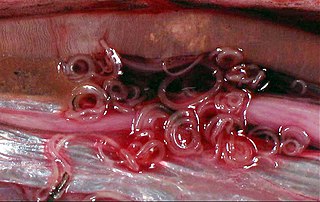| Enoplia | |
|---|---|
| Scientific classification | |
| Domain: | Eukaryota |
| Kingdom: | Animalia |
| Phylum: | Nematoda |
| Class: | Enoplea |
| Subclass: | Enoplia Pearse, 1942 |
| Orders | |
The Enoplia are a subclass of nematodes in the class Enoplea.
| Enoplia | |
|---|---|
| Scientific classification | |
| Domain: | Eukaryota |
| Kingdom: | Animalia |
| Phylum: | Nematoda |
| Class: | Enoplea |
| Subclass: | Enoplia Pearse, 1942 |
| Orders | |
The Enoplia are a subclass of nematodes in the class Enoplea.
Enoplians are characterized by amphids shaped like ovals, stirrups, or pouches. Their bodies are smooth, without rings or lines. The esophagus is cylindrical and glandular. [1]
Lorenzen described two orders, Enoplida and Trefusiida, in the 1980s based on morphology. With the advent of phylogenetic analysis, a reorganisation has been necessary, moving the Triplonchida here to create three orders and expanding it. [1] [2] [3]
The orders are distinguished mainly by habitat type. [4] [3]
Enoplia is regarded as the earliest nematode branch, according to recent phylogenetic analysis. [5] Enoplia is mentioned as a sister clade to Dorylaima and Chromadoria. [5] [6]
Leptosomatidae is a family of benthic marine nematode worms.

Enoplea (enopleans) is a class, which with the classes Secernentea and Chromadorea make up the phylum Nematoda in current taxonomy. The Enoplea are considered to be a more ancestral group than the Chromadorea, and researchers have referred to its members as the "ancestrally diverged nematodes", compared to the "more recently diverged nematodes" of Chromadorea.

Secernentea was a class of nematodes in the Classical Phylogeny System and is no longer in use. This morphological-based classification system has been replaced by the Modern Phylogeny system, where taxonomy assignment is based on small subunit ribosomal DNA.

The Chromadorea are a class of the roundworm phylum, Nematoda. They contain a single subclass (Chromadoria) and several orders. With such a redundant arrangement, the Chromadoria are liable to be divided if the orders are found to form several clades, or abandoned if they are found to constitute a single radiation.
Pratylenchus brachyurus is a plant parasitic nematode.

Diplogasterida was an order of nematodes. It was sometimes placed in a monotypic subclass Diplogasteria, but molecular phylogenetic evidence has shown it to be embedded in the family Rhabditidae. The confusion of having a hierarchical nesting of groups that were formerly mutually exclusive has led to a profusion of names. Although completely revised taxonomy of nematodes that builds on recent classification systems as well as recent phylogenetic evidence is still necessary, most contemporary taxonomic studies now treat all groups listed under "Diplogasterina" below as a single family, Diplogastridae.

The nematodes, roundworms or eelworms constitute the phylum Nematoda. They are a diverse animal phylum inhabiting a broad range of environments. Most species are free-living, feeding on microorganisms, but there are many that are parasitic. The parasitic worms (helminths) are the cause of soil-transmitted helminthiases.
Enoplida is an order of nematodes. It is one of two orders in Enoplia, which is one of two subclasses in Class Enoplea.
Dorylaimia is a subclass of nematodes.
Ingenia is a genus of marine nematode worms native to Brazil, with a single known species, I. mirabilis. It belongs to the Tripyloididae, which is a group that are mostly free-living and which feed on diatoms and other algaes.
Paratrichodorus is a genus of terrestrial root feeding (stubby-root) nematodes in the Trichodoridae family (trichorids), being one of five genera. They are economically important plant parasites and virus vectors. The females are didelphic, and are distributed worldwide.
Triplonchida is an order of terrestrial nematodes, and is one of two orders making up the subclass Enoplia.
Diphtherophorina is a suborder of terrestrial nematodes, being one of three that constitute suborder Triplonchida.
Trichodoridae is a family of terrestrial root feeding nematodes, being one of two that constitute suborder Triplonchida. They are economically important plant parasites and virus vectors.

Trichodorus is a genus of terrestrial root feeding (stubby-root) nematodes in the Trichodoridae family (trichorids), being one of five genera. They are economically important plant parasites and virus vectors.
Strongyloides serpentis is a parasitic roundworm infecting the intestine of the green water snake, hence its name. It was first described from Louisiana.
Bunonematidae is a family of nematodes in the order Rhabditida.
Phasmarhabditis californica is a nematode in the family Rhabditidae. It is a lethal facultative parasite of terrestrial gastropods.
Phasmarhabditis (Greek: Phasma = (φάσμα ; rhabditis = is a genus of bacterial-feeding nematodes which are facultative parasites whose primary hosts are terrestrial gastropods. The name comes from Greek: Phasma- (φάσμα ; rhabditis = rod-like (ῥάβδος. The genus is made up of 18 species including P. hermaphrodita, P. californica, P. neopapillosa, P. papillosa, P. apuliae, P. bohemica, P. bonaquaense, P. huizhouensis, P. nidrosiensis, P. valida and P. tawfiki.
Myolaimidae is a family of nematodes in the order Rhabditida. It consists of two genera, Myolaimus and Deleyia.